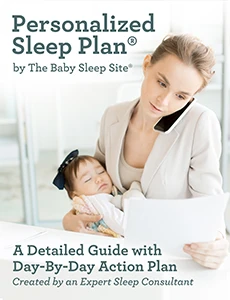
When is the best age to sleep train your baby? As parents, we always want sleep training to go as well as possible, right from the start. After all, sleep training often involves some amount of crying no matter how gently you try to do it. In this article, I’ll share what I believe are the best ages to sleep train based on my experience as a pediatric sleep consultant for over 15 years.
Your Baby’s Ideal Sleep Training Windows
While you can do sleep training with newborns when your sleep problems just can’t wait to be fixed, we find it works best if you wait until at least 4 to 6 months old. We also find it’s ideal to wait until your baby can stop being swaddled. No matter when you start, it’s never too late! Sleep training usually goes a bit easier if you do it during one of these windows:
The 4-6 month window
The 4- to 6-month-old age range is often one of the best times to start sleep training. Why? At this point, your baby is past the 4-month sleep regression, so they are starting to develop more “adult” sleep patterns. Your baby is also much less mobile at this stage than they’ll be in a few more weeks or months, and that lack of mobility makes sleep training a bit easier. In addition, babies will start to experience separation anxiety around 7-8 months old.
Finally, because your baby is still quite young at this point, any sleep associations she may have formed won’t have had time to turn into strong habits. That means they’ll be easier to change. For babies younger than this, our e-book, Essential Keys To Your Newborn’s Sleep outlines newborn-friendly sleep coaching strategies for your newborn, including sample sleep-inducing routines. We also offer special newborn-focused Personalized Sleep Plans® to guide your family to better sleep in a gentle, safe way.
The only drawback in sleep training at this age is that many babies still have night feedings which can complicate things. This brings me to the next ideal sleep training window.
You may also be interested in…
The 11-16 month window
The next ideal sleep training window is over 10 months old and less than 18 months old. Because your baby is past the sleep regression that happens at 8/9/10 months, their sleep patterns should be back to normal. (Although if your baby has never been a great sleeper, her “normal” sleep patterns may be fairly chaotic! 🙂 Remember, it’s best to sleep train when things are as “normal” as possible, so waiting until a sleep regression has passed can be a good idea. Just make sure your toddler’s schedule is age-appropriate, first, as that can do wonders!
You may also be interested in…
Less Ideal Times For Sleep Training
In general, it’s best to avoid sleep training during a sleep regression. And, if possible, try to sleep coach before your little one is 18 months old; after 18 months, your toddler’s growing sense of independence and willfulness might make sleep training tougher.
But be careful – don’t let this information paralyze you, or make you put off or give up on sleep training! While sleep training may go a little more smoothly if you do it during one of these two windows, you can sleep train any time. I even worked with one family with a 4-year-old who had been bed-sharing since he was a baby. We successfully transitioned him to his own bed and bedroom!
“Although there are more ‘ideal’ times to sleep train than others such as before your baby can pull up and stand at the side of the crib, if you and your family are ready to make big changes, I wouldn’t wait just because of your baby or toddler’s age. Every baby is different and you know your baby best. It may take a bit more time and patience, but it can work! There is always a reason to put off making positive changes in your life whether it’s delaying a diet because the holidays are near or work is too busy or you put off budgeting because you have too many bills, you can always find a reason to avoid the hard work that sleep training sometimes entails. The first step is the hardest, but I find families are happily surprised when their child adapts to the new routines faster than they anticipated. Carpe Diem! (Seize the Day!)”
Need More Baby Sleep Training Resources?
Here are more resources for you to help your baby sleep better:








